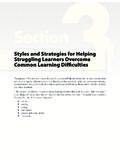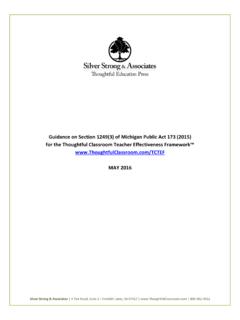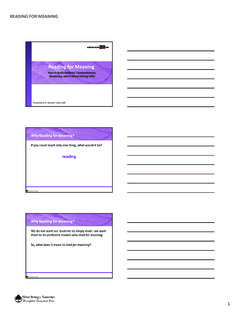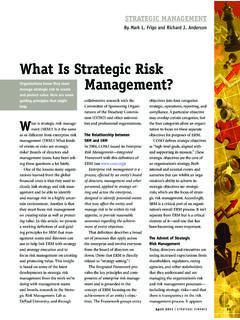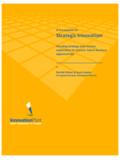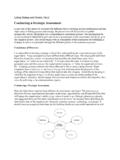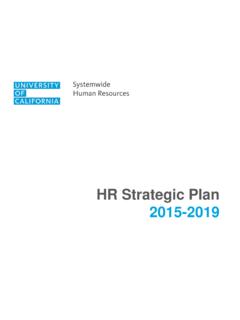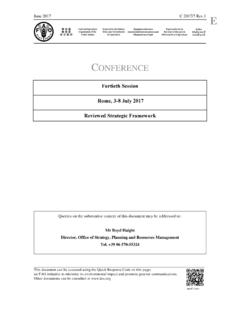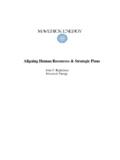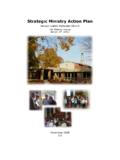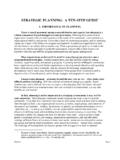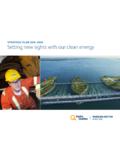Transcription of The Thoughtful Classroom Program
1 The Thoughtful Classroom Program Becoming a strategic Teacher: Better Instruction, Deeper Learning, Higher Achievement One of the greatest challenges facing today s school leaders is the challenge of raising the expertise of their teachers. We hear more calls for teacher effectiveness than ever before, and we are seeing that teacher effectiveness is becoming a significant part of the national discussion on education. Everybody agrees that what teachers do in the Classroom matters deeply. A recent investigation into the practices of the world s top 25 school systems put it this way: The quality of an education system cannot exceed the quality of its teachers (Barber & Mourshed, 2007). In fact, a wide body of research shows that the single greatest factor affecting student achievement is Classroom instruction. In one study, Mortimore & Sammons (1987) found that Classroom instruction has more impact on student learning than any other factor more important than the next six factors they studied combined.
2 As McKinsey & Company concluded in their study of the world s best schools, The only way to improve outcomes is to improve instruction. Obviously, we all wish for our teachers to be more Thoughtful and effective in designing and delivering instruction that raises student achievement. In The Thoughtful Classroom , we call these teachers strategic teachers, and for three reasons: 1. strategic teachers have a repertoire of research-based instructional strategies at their disposal. 2. strategic teachers understand how and when to use particular strategies in their classrooms. They can select strategies that support their objectives and adapt strategies to meet particular learning goals. In other words, their overall approach to instruction is strategic . 3. strategic teachers understand that their fellow educators are their greatest resource. That s why strategic teachers seek out opportunities to work and learn with colleagues.
3 It s also why strategic school leaders seek to develop a school culture that supports teachers as they work together to master new strategies and refine their practice. More than ever, administrators are being asked to play a larger role in building teachers expertise because high-performing schools lead to the development of more strategic teachers. Let s take a closer look at each of these reasons behind strategic teaching as separate elements. Element One: Research-Based Instructional Strategies In the book The strategic Teacher (Silver, Strong, & Perini, 2007), we ve collected 20 of the most reliable and flexible research-based strategies and organized them into four distinct styles of instruction: a Mastery style that emphasizes the development of student memory; an Understanding style that seeks to expand students capacities to reason and explain; a Self-Expressive style that stimulates and nourishes students imaginations and creativity; and an Interpersonal style that helps students find meaning in the relationships they forge as partners and team members, united in the act of learning.
4 Why such a premium on strategies? Because teachers need strategies if they are going to become experts. When strategies are used well, they work plain and simple. The strategies in The strategic Teacher, for example, are all based on solid research and over 35 years of Classroom practice. But beyond that, strategies are the answer to so many questions and pressures that today s teachers face, questions like: 1. How can I differentiate instruction so that more of my students succeed? The answer is research-based strategies. Because different strategies highlight different styles of thinking, they can help teachers reach more students especially those students who feel that their styles of thinking are ignored in school. 2. I ve got Common Core State Standards and state assessment tests staring me down. How can I help my students develop the skills they need to be successful?
5 Again research-based strategies are a good answer because strategies build core academic skills. 3. How can I increase student engagement? Research-based strategies, because they use what we call motivational levers like controversy, choice, competition, challenge, and curiosity to capture student interest and secure their commitment to learning. 4. How can I deepen student understanding? Research-based strategies, because we know from the research of Robert Sternberg (2006) that using multiple styles of teaching leads to greater retention, deeper comprehension, and higher achievement scores. Citing a number of studies involving students of different grade levels across a wide range of content areas, Sternberg reports that students in courses that emphasized different styles of instruction did better on both objective tests and performance assessments.
6 Sternberg concludes that multi-style instruction raises achievement because it enables students to capitalize on their strengths and to correct or to compensate for their weaknesses, encoding material in a variety of interesting ways (pp. 33-34). In short, strategies help teachers do their work better while, at the same time, helping students become better thinkers and learners. Element Two: Applying Strategies to the Right Classroom Situations It s important to understand that knowing some strategies does not ensure teacher effectiveness. In fact, the same lines of research that give us our strategies also carry a warning. For example, a new analysis of teacher effectiveness by Peggy Schooling, Michael Toth, and Robert Marzano (2010) shows that simply using research-based strategies in the Classroom does not guarantee that student learning will increase.
7 In fact, the research shows that some teachers use research-based strategies and see negative results. Why? One reason is that teachers may be using the wrong strategies at the wrong time. Because different strategies are suited to different types of lessons, applying a strategy without first aligning it to clear instructional outcomes can hinder student learning. In response, we developed the strategic Dashboard, a simple one-page decision-making tool built off the findings of some of today s leading thinkers in education. Each of the 20 strategies in The strategic Teacher comes with its own strategic Dashboard in order to make it easy for teachers to decide when a strategy is right for their particular objectives. (See Figure 1 for a sample strategic Dashboard.) Figure 1: Reading for Meaning Dashboard You ll see that the strategic Dashboard helps teachers answer key questions related to their instructional goals.
8 Using a dashboard, a teacher can quickly determine how the strategy can be used to to differentiate instruction and motivate different styles of learners; what skills, facets of understanding, and types of knowledge the strategy develops in students; and how the strategy is supported by research. You ll also notice that the top left section of the dashboard focuses specifically on instructional design. That s because strategic teachers see strategies as more than ways to cover specific content or build particular skills. Instead, strategic teachers take a longer view, integrating strategies into their larger lesson and unit designs. By synthesizing the insights of the best lesson design models (Hunter, 1984; Wiggins & McTighe, 2005; Marzano, 2007) with what we ve learned from teachers over the years, we ve identified five questions that every teacher needs to answer when developing a lesson or unit.
9 Figure 2 shows these five questions organized on an instructional design tool we call a unit blueprint. Figure 2: A Unit Blueprint Preparing Students for New Learning How do you establish your purpose, activate students prior knowledge, and prepare them for learning? Deepening and Reinforcing Learning How do you help students solidify their understanding and practice new skills? Presenting New Learning How do you present new information and provide opportunities for students to actively engage with content? Reflecting on and Celebrating Learning How do you help students look back on their learning and refine their learning process? Assessing Learning How do students demonstrate their learning and what kinds of evidence do you collect to assess their progress? We have found that helping teachers think about their overall instructional designs as a blueprint greatly accelerates their ability to align strategies to the bigger picture of student learning.
10 Element Three: Collaborative Learning and Support Structures A second reason that research-based strategies may not improve learning has to do with a teacher s level of expertise. A teacher may apply a strategy to an appropriate Classroom situation and the results may still disappoint if the teacher lacks the expertise to use the strategy correctly or well. But we must remember that developing expertise takes time and support. It is both foolish and unfair to expect new teachers to apply new strategies like experts. To help teachers master new strategies and to help school leaders build a culture more conducive to the kind of professional learning that builds teachers expertise, we ve developed with ASCD a new kind of professional development tool called a strategic Teacher PLC Guide. We designed these PLC Guides with some very specific and frankly very troubling research in mind: Bruce Joyce and Beverly Showers (2002) have found that for most professional development initiatives, less that 10% of what teachers learn makes it into the Classroom .
